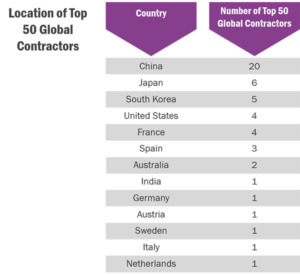The global engineering, construction and infrastructure (ECI) industry landscape is changing at an unprecedented rate. In this blog, I will outline what construction companies need to do to be a winner in the industry.
A CHANGING INDUSTRY
One way of measuring the rate of change in the industry is to look at the geography of the largest construction companies.

China has complete dominance based on the number of largest global contractors. Among ENR’s Top 50 contractors, 68 percent are in Asia, 24 percent in Europe and 8 percent in the United States.

In ENR’s accounting of contractors performing work internationally, you can see that Europe has been the big loser over the last eight years in volume of work performed outside of its home countries. If this trend continues, in another five years it would seem likely that Asia with have over 60 percent of the top 100 companies, the Americas about 25 percent and Europe being left with less than 15 percent.
One thing is certain, the global competitive landscape is changing at an extremely rapid pace and companies need to recognize that competition is going to intensify.
NEW AND INTENSIFYING COMPETITION
To make things even tougher, new competitors from outside the industry are entering the market. A main reasons for this is the need for the industry to transition to a construction-integrated manufacturing model, often referred to as offsite or modular manufacturing.
This model is changing the construction process from performing 95 percent of the work on a construction site to perhaps more than 75 percent of the work done in offsite manufacturing or fabrication facilities with the components or modules being shipped to site for final erection and assembly. There are several contributing factors driving the acceleration of this trend including a global skills shortage, but the real driver is the need to build higher quality assets faster and at lower cost.
IT’S TIME TO ADAPT
The ECI industry must rapidly transition from non-integrated document-driven processes and systems to data-driven digital asset lifecycle processes and systems. Technologies like BIM (Building Information Modelling), robotics, augmented reality, drones and IoT are going to transform the industry.
Clients are becoming more demanding as they want the contractor to not just construct the asset, but take responsibility for operating and maintaining the asset after it is built. Ultimately, they will ask the construction companies to contract not for a finished asset but for outcomes over the asset’s life.
The successful companies in the future will therefore no longer simply be responsible for the construction of the asset but are also likely to have to become manufacturing and service management businesses.
Today, many construction companies are making very low margins, some even experiencing losses. Most companies are running their businesses using old fashioned processes and non-integrated systems. We see this causing many construction companies, both large and small, to go out of business.
BUILD FOR THE FUTURE
For construction companies to build for the future, they must anticipate future market demands, and change business processes and solution capabilities. Here’s how you can get started.
The first step is getting control of your business and ensuring you have accurate, real-time information about how your projects are performing. Of course, this is easier said than done and might require changing your processes and business systems to a more integrated solution.
Once this foundation is in place, your business will be in position to transform quickly to support new business models, such as offsite manufacturing or service management. This foundation will also allow your business to integrate the latest digital asset lifecycle technologies into your business processes, like BIM and IoT as mentioned above.
In summary, you need to disrupt or be disrupted. The choice is up to you.
ERP Pricing: Get 2019 pricing on 45 different ERP systems. Click to download your free guide.





